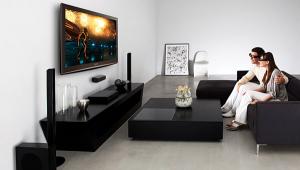HT Measurements Explained: The RGB Triangle of Death - Video Measurements
It's only fitting that our video measurements be displayed in an obscure, almost-illegible triangle. Three-sided geometric shapes have always been somewhat mysterious objects, implying power or fear. Our measurements can do both. In this, our second attempt to explain to you, our faithful readers, what the ancillary boxes labeled "HT Labs Measures" mean, we'll discuss what our detractors call the triangle of death, why we use it in our display measurements, and what it means to you.
 The triangle is a cheap knock-off representation of the more amoeba-shaped CIE diagram (see Figure A). The CIE chart is a graphical representation of all the colors visible to the human eye. Green is near the top, red is on the lower right, blue is at the bottom left, and all the other colors (which are combinations of these three) are in between. Within that amoeba-shaped chart is another amoeba-shaped outline representing those colors that are visible only when light is reflected off of a surface. After all, you can't see something unless light reflects off of it, right? Therefore, when engineers created our NTSC (analog) and ATSC (digital) TV systems, they figured, why waste time reproducing colors that people can't see? With that, they chose three phosphors, or colors, that—when blended in various combinations—could create any color within a triangle that engulfed most of the surface colors. In reality, our measurements triangle (see Figure B) is a copy of their triangle. In either case, the triangle expands to include more colors in the ATSC system than it does in the NTSC system.
The triangle is a cheap knock-off representation of the more amoeba-shaped CIE diagram (see Figure A). The CIE chart is a graphical representation of all the colors visible to the human eye. Green is near the top, red is on the lower right, blue is at the bottom left, and all the other colors (which are combinations of these three) are in between. Within that amoeba-shaped chart is another amoeba-shaped outline representing those colors that are visible only when light is reflected off of a surface. After all, you can't see something unless light reflects off of it, right? Therefore, when engineers created our NTSC (analog) and ATSC (digital) TV systems, they figured, why waste time reproducing colors that people can't see? With that, they chose three phosphors, or colors, that—when blended in various combinations—could create any color within a triangle that engulfed most of the surface colors. In reality, our measurements triangle (see Figure B) is a copy of their triangle. In either case, the triangle expands to include more colors in the ATSC system than it does in the NTSC system.

The first piece of useful info you can glean from our chart is how a display's pure colors match up to the requirements of the system. If a display's red, green, and blue phosphors don't create a triangle that can encompass all of the system's colors, then the television will be unable to create particular hues. Take, for example, a TV that uses a red phosphor that's not quite as red as the one specified by SMPTE. The TV can only go as deep as the red phosphor itself. No matter what the display's color or tint settings are, the TV will never create a true, deep red if the program calls for it. Some manufacturers, especially those building front projectors, will use red phosphors that are a bit orange and green phosphors that are a tad yellow. These phosphors are typically brighter than true red and green phosphors, thus making a display that's brighter than the competition, but at the sacrifice of true color fidelity. While CRT displays use phosphors to create colors, LCD and DLP devices use filters; the same rules apply.
The second piece of information you can gather from the chart is how the gray scale affects the picture. The gray scale, also known as color temperature or white balance, is a measure of the "color" of white or various shades of gray in degrees Kelvin. Since our TV systems, both analog and digital, start with a black-and-white (luminance) base signal and then add color (chrominance) on top of it, we want to make sure the "colors" of that black-and-white signal are truly black and white. We measure the gray scale at different intensities from dark gray to bright white and plot each measurement within the triangle. The accurate level would be near the center of the triangle, as the combination of red, green, and blue light would create white. (For more information on the color of gray, see our Color Temperature Face Off from the February '99 issue.)

















































